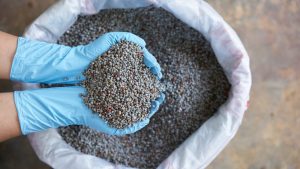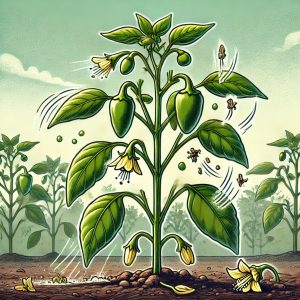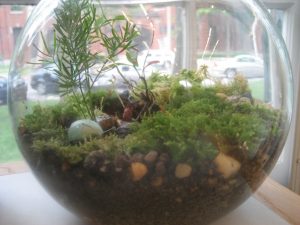Last Updated on March 22, 2024 by teamobn
Our elderly neighbors knocked on our doors one early morning, asking for help. They discovered a nest of yellow jackets in their backyard and their grandchildren are coming over the following week. They didn’t want to expose the kids to the said insects.
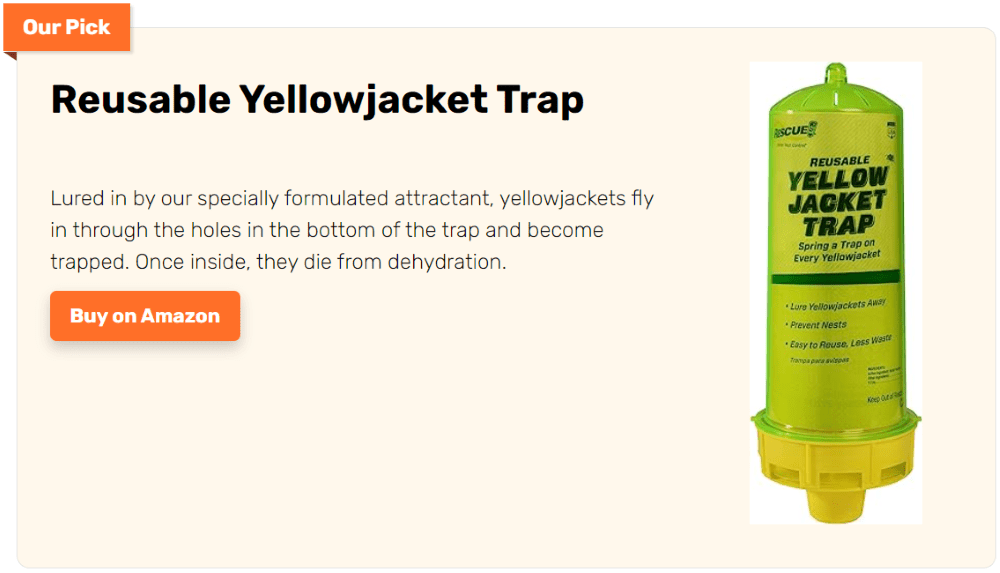
Yellowjackets are dangerous. They are more aggressive compared to other stinging insects like wasps, bees, and hornets. Because they don’t lose their stinger, they can actually jab at your skin several times over. And they usually attack even when unprovoked.
To slowly get rid of the insects, my husband made several yellow jacket bottle traps. It practically cost nothing because we had a lot of bottles at home waiting to be recycled. Making the bottle traps was a good way to recycle them.
Making a Yellow Jacket Bottle Trap
Contents
Materials
- Red wine
- Water or soda bottle
- Dishwashing liquid
Tools
- Bread knife
- Scissors
Instructions
Step 1: Prepare the Bottle
- Rinse the yellow jacket bottle trap of any dirt or oil before proceeding. Remove any labels to allow for clear visibility inside the bottle.
Step 2: Cut the Bottle
- Using the bread knife, carefully cut the top third of the bottle off. This cut should be made just above where the bottle starts to narrow towards the opening.
Step 3: Create the Bait Solution
- In the bottom section of the bottle, pour a mixture of red wine and a few drops of dishwashing liquid. The dishwashing liquid breaks the surface tension of the wine, making it harder for yellow jackets to escape once they touch the liquid.
Step 4: Insert the Funnel
- Take the top third of the bottle that was cut off and invert it, placing it into the bottom section like a funnel. The bottle’s neck should be pointing downwards. Secure the two pieces together using the scissors to make small slits and tabs if necessary, or use tape around the edges for a firmer hold.
Step 5: Place the Trap
- Position your trap in an area where you’ve noticed yellow jacket activity. Avoid placing it too close to human activity to prevent attracting the insects towards yourself or others. Elevated positions near yellow jacket flight paths are ideal.
Step 6: Maintenance
- Check the trap regularly. Once you’ve captured a significant number of yellow jackets or if the bait solution evaporates, dispose of the contents safely. Replace the bait solution and reset the trap as needed.
Step 7: Disposal
- To dispose of the captured yellow jackets, carefully remove the funnel part of the trap, cover the bottom section, and dispose of it properly. Ensure this is done cautiously to avoid any risks of stings.
Click on any image to start the lightbox display. Use your Esc key to close the lightbox.


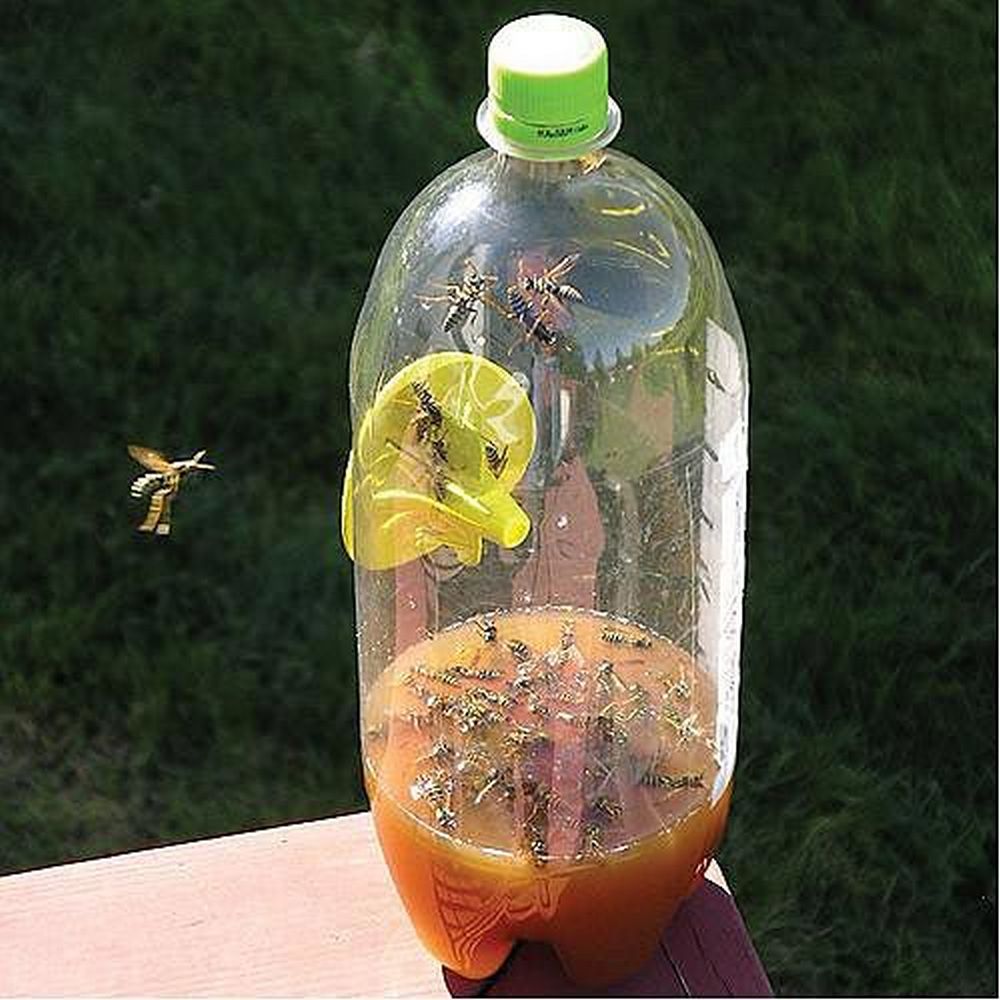
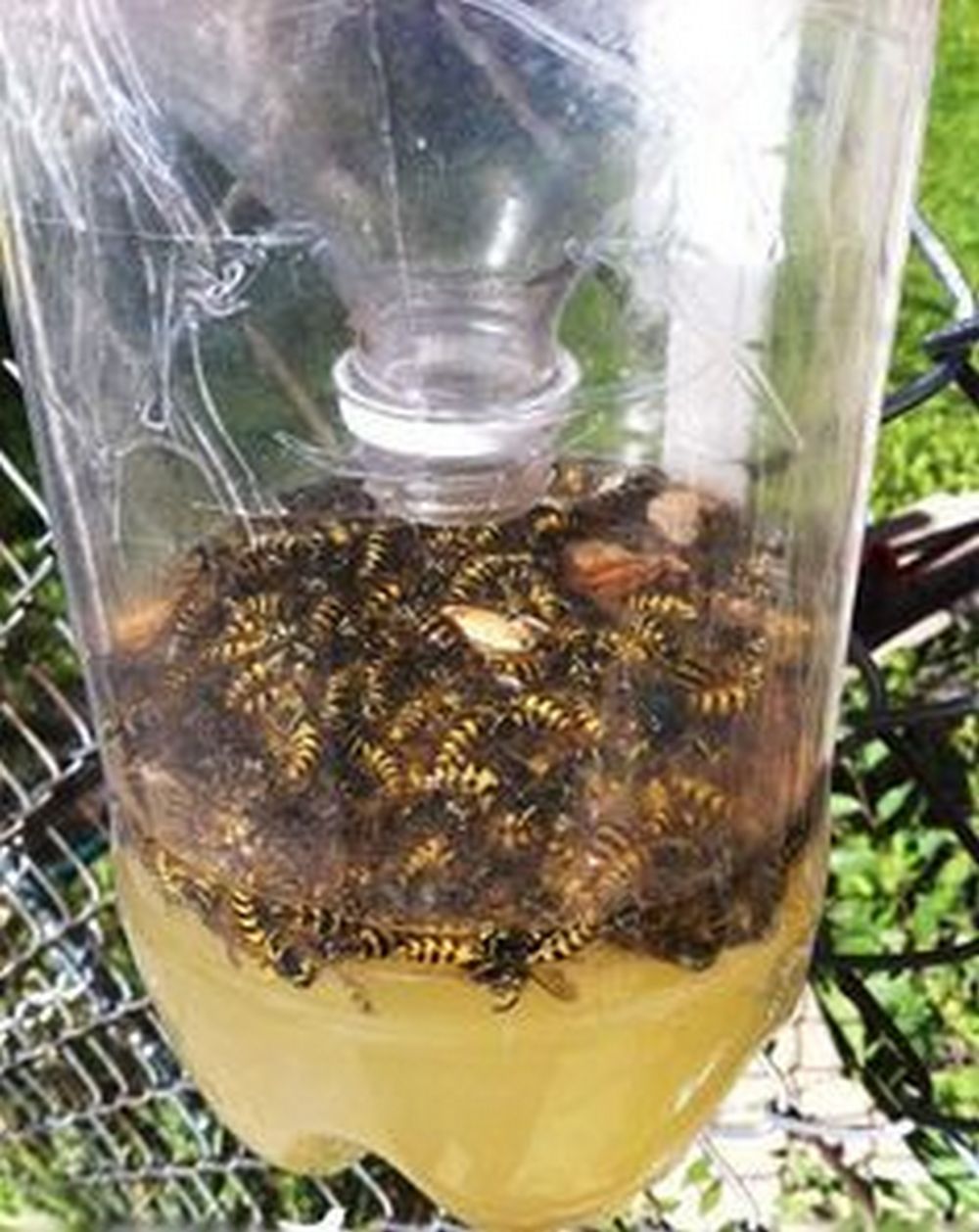
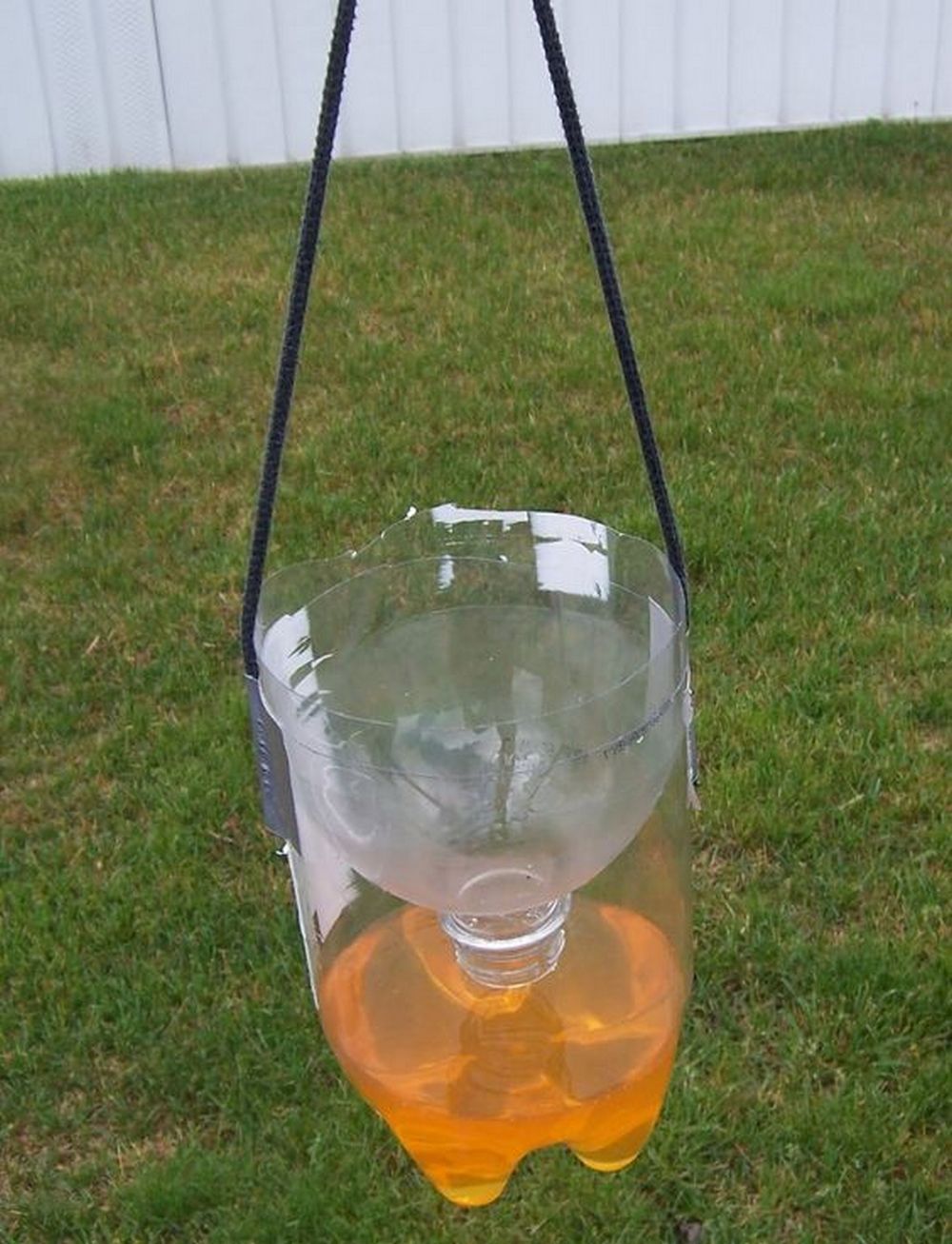
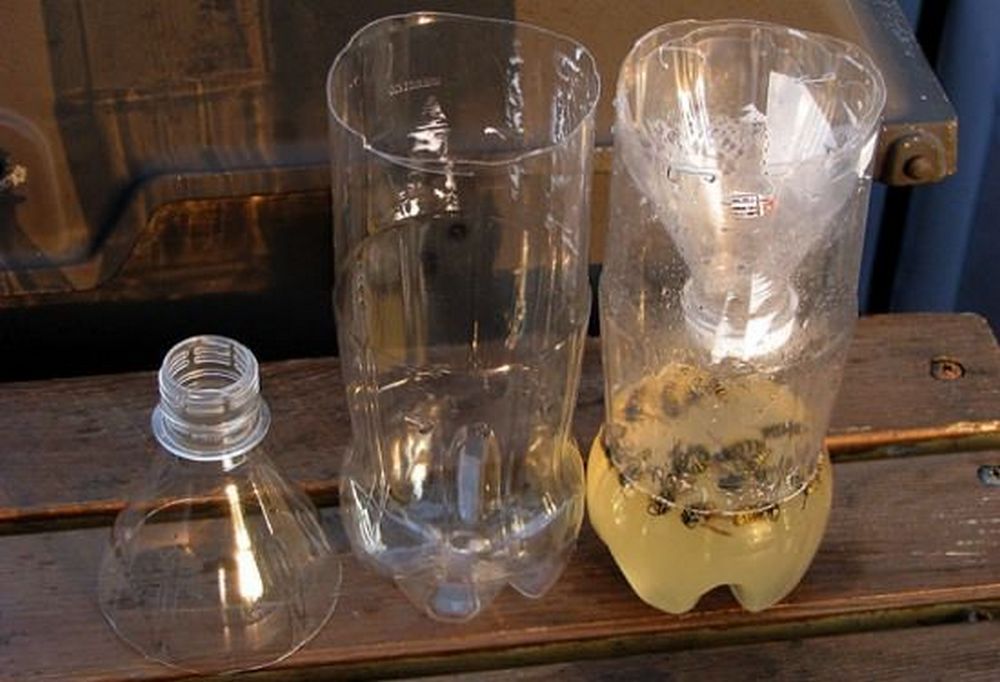



Benefits of Using Bottle Traps
Using yellow jacket bottle traps offers a simple, effective, and environmentally friendly way to manage yellow jacket populations around your home or garden. This method not only helps in reducing the number of these potentially dangerous pests but also comes with several other significant advantages.
Eco-Friendly Solution
Yellow jacket bottle traps provide a greener alternative to chemical insecticides. By utilizing household items and natural substances like red wine, these traps avoid the introduction of harmful chemicals into your environment. This approach safeguards the health of your family, pets, and beneficial insects, contributing to a healthier ecosystem around your home.
Cost-Effective
One of the most appealing aspects of yellow jacket bottle traps is their cost-effectiveness. Utilizing empty water or soda bottles and basic kitchen supplies means you can construct an efficient trap with minimal expense. This DIY solution eliminates the need for costly professional pest control services or the purchase of specialized trapping equipment.
User-Friendly Design
The simplicity of designing and setting up a yellow jacket bottle trap makes it accessible to everyone. With straightforward materials and tools, anyone can create a trap in just a few steps. This ease of use ensures that effective pest control is within reach of all households, regardless of budget or DIY skill level.
Targeted Pest Control
Yellow jacket bottle traps are highly specific in their target, focusing on attracting and capturing yellow jackets without harming other insects. This specificity is crucial for maintaining the balance of your local ecosystem, as it preserves beneficial insects like bees and butterflies that play vital roles in pollination and other ecological functions.
Reusability and Sustainability
These traps can be emptied, cleaned, and reused multiple times throughout the yellow jacket season, making them a sustainable option for ongoing pest management. The reusability of yellow jacket bottle traps not only contributes to their cost-effectiveness but also aligns with principles of waste reduction and environmental stewardship.
Safety
By attracting yellow jackets to a contained trap away from human activity, these bottle traps improve the safety of outdoor living spaces. This method reduces the likelihood of stings, which is particularly important for families with children or individuals with allergies to insect stings. The traps can be placed strategically to draw yellow jackets away from areas of high human traffic, further enhancing safety.
In conclusion, yellow jacket bottle traps offer an eco-friendly, affordable, and effective solution for managing yellow jacket populations. Their ease of use, specificity, and safety make them an ideal choice for those looking to protect their homes from these pests while minimizing environmental impact.
Understanding Yellow Jackets
Yellow jackets are often mistaken for bees due to their similar size and appearance, but these insects have distinct behaviors and ecological roles. Understanding these differences is crucial when dealing with an infestation and utilizing yellow jacket bottle traps effectively. This knowledge not only aids in the successful capture of these pests but also in preventing future invasions.
Identification and Behavior
Yellow jackets are social wasps characterized by their distinctive yellow and black markings. Unlike bees, they can sting multiple times, making them a significant concern for people, especially those with allergies to stings. They are particularly aggressive when their nest is threatened, a behavior that underscores the importance of a cautious approach and the use of non-invasive methods like yellow jacket bottle traps for control.
Habitat and Nesting Patterns
Typically, yellow jackets nest in the ground or cavities within walls and structures. Identifying these nests can be challenging, and disturbing them inadvertently can provoke aggressive behavior. Therefore, deploying yellow jacket bottle traps around areas of suspected activity can help reduce populations safely without directly interacting with nests.
Diet and Attraction to Traps
Yellow jackets are omnivorous, feeding on proteins as well as sugary substances. This dietary preference is what makes yellow jacket bottle traps so effective. By using attractants like red wine mixed with dishwashing liquid, the traps exploit these preferences, drawing yellow jackets away from human activities and effectively reducing their numbers.
The Role of Yellow Jackets in Ecosystems
Despite their reputation as pests, yellow jackets play a vital role in controlling insect populations, acting as natural pest control by feeding on other insects. Understanding this ecological role highlights the importance of targeted control methods like yellow jacket bottle traps, which minimize impact on the ecosystem while protecting humans from stings and infestations.
The Importance of Timing
The effectiveness of yellow jacket bottle traps can vary throughout the year. Late summer and early fall are when yellow jackets are most active and aggressive, making it an optimal time to set up traps. Understanding these seasonal behaviors can significantly enhance the effectiveness of trapping efforts, ensuring a safer outdoor environment for everyone.
A thorough understanding of yellow jackets is essential for effective pest management. Yellow jacket bottle traps offer a safe, non-invasive solution to managing these pests, reducing the risk of stings and allowing for peaceful coexistence with these complex creatures.
Placement Tips for Maximum Effectiveness
The strategic placement of yellow jacket bottle traps is crucial for maximizing their effectiveness. Proper positioning ensures that the traps attract as many yellow jackets as possible while minimizing risks to humans and beneficial insects. Following these tips can enhance the efficiency of your yellow jacket control efforts, creating safer and more enjoyable outdoor spaces.
Selecting the Right Location
- Away from Human Activity: To prevent attracting yellow jackets to areas frequently used by people, place the traps at least 20 feet away from patios, playgrounds, and other outdoor living spaces. This distance helps draw yellow jackets away from these areas, reducing the likelihood of encounters.
- Near Nesting Sites: If you’ve identified areas where yellow jackets are nesting or entering and exiting your home’s exterior, positioning traps nearby can intercept these pests before they become a nuisance. However, ensure the traps are not so close that they disrupt the nest and provoke aggression.
- In Sunlit Areas: Yellow jackets are more active in sunlit areas, so placing traps in direct sunlight can increase their visibility and attractiveness to these insects.
Height and Accessibility
- Elevated Positions: Hanging the traps from tree branches or hooks at a height of 4 to 6 feet can improve visibility and access for yellow jackets. Ensure the trap is secure to prevent it from falling and potentially releasing captured yellow jackets.
- Open Spaces: Place the traps in open areas rather than dense vegetation to ensure they are easily accessible to yellow jackets. Visibility is key to attracting these pests to the trap.
Multiple Traps
- Strategic Distribution: For larger areas or significant yellow jacket activity, consider placing multiple yellow jacket bottle traps around the perimeter of your property. This ensures comprehensive coverage and enhances the overall capture rate.
Regular Maintenance
- Monitoring and Maintenance: Regularly check the traps for captures and to ensure the bait solution remains effective. Replace or refill the bait as needed, and clean the traps to maintain their attractiveness to yellow jackets.
Adjustments Based on Observations
- Adapt Placement Over Time: Monitor the effectiveness of trap placements and make adjustments as needed. If certain traps are capturing fewer yellow jackets, try moving them to different locations based on observed patterns of yellow jacket activity.
By adhering to these placement tips, you can significantly enhance the effectiveness of your yellow jacket bottle traps. Strategic positioning combined with regular maintenance ensures that these traps serve as an effective tool in managing yellow jacket populations, helping to maintain a safer and more pleasant outdoor environment.
Conclusion
Crafting a yellow jacket bottle trap offers an efficient and environmentally friendly solution to manage yellow jacket populations around your home. With strategic placement and regular maintenance, these traps can significantly reduce the presence of these pests, ensuring safer outdoor spaces for everyone. Embracing this method not only demonstrates a commitment to eco-friendly pest control but also enhances the enjoyment of your outdoor areas free from the threat of stings.
Another kind of creature you want to keep away but avoid harming is birds. Read our post on safely blocking birds from your garden!

